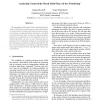365 search results - page 14 / 73 » Collaboration Improves the Connectivity of Wireless Networks |
PERCOM
2004
ACM
14 years 7 months ago
2004
ACM
We investigate the theoretical limits of positioning algorithms. In particular, we study scenarios where the nodes do not receive anchors directly (multi-hop) and where no physica...
ICWN
2003
13 years 8 months ago
2003
The portability of new miniaturized devices, together with their ability to connect conveniently to networks in different places, makes mobile computing possible. Recent advances ...
ACSC
2007
IEEE
14 years 1 months ago
2007
IEEE
With the continuous growth of mobile users and web-based wireless applications, the performance of accessing web services via wireless is becoming one of the key issues. Regular T...
PIMRC
2010
IEEE
13 years 5 months ago
2010
IEEE
Wireless multihop ad hoc networks face a multitude of challenging problems including highly dynamic multihop topologies, lossy and noisy communications channels, and sporadic conne...
ICC
2008
IEEE
14 years 1 months ago
2008
IEEE
— In large Wireless Sensor Networks (WSNs), each hop might incur varying delays due to medium access contention, transmission and computation delays. Fast and efficient query re...

